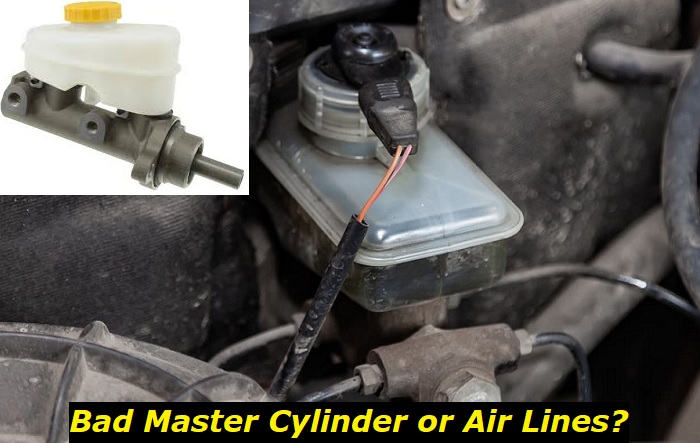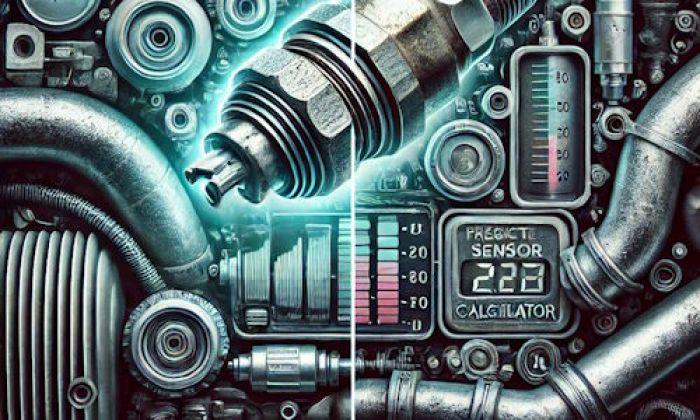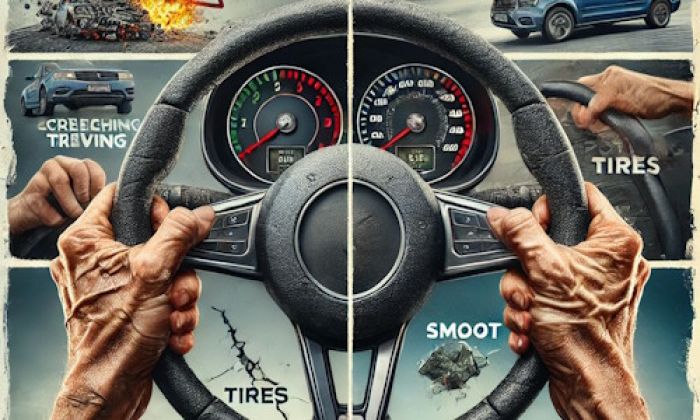When things are running as they should, we aren't really concerned about what particular parts of our vehicles do. As soon as a problem arises, it becomes necessary to isolate its root. Suppose your car has developed complications caused by the master cylinder or airlines. In that case, this article is here to help you pinpoint the source.
Common brake problems highlights
- Level of urgency:super-urgent
- DIY diagnostics:possible but not recommended
- DIY repairs:impossible
- Price for repair:$150 - $450
- Common symptoms:issues with braking, car brakes on its own, brakes are inefficient, sounds when braking
- Commonreasons:fluid issues, caliper problems, cylinders problems, brake booster issues
- If ignored:no brakes, accidents, dangerous situations

The Difference in Function Between a Master Cylinder and Air Line
Whenever you are driving your vehicle and want to slow down or stop, you will rely on your car's master cylinder to stop the car. The work of the master cylinder is to translate the force you apply on the brake pedal into hydraulic pressure.
The brake master cylinder allows the pressure you apply on the brake pedal to be converted by transferring the brake fluid to the braking circuit. The brake master is tasked to do this regardless of your car's brakes, be it drum brakes or disc brakes.
Airlines are tubes that run in and out of each air strut of your vehicle. The airlines assist in taking air to your air strut from your vehicle's vacuum manifold. Air suspension is used as an alternative to the standard suspension in most modern cars being produced today. The air suspension system was designed to shield the vehicle when traveling along a road that is not in good condition.
The air suspension system helps the vehicle stay stable when driving on lousy terrain and when the car is turning. The difference between air suspension and fluid-filled shocks is that the air suspension system relies on the suspension airbags to be filled with air through an air compressor than the springs and shocks for support as in the standard suspension.
Signs Of a Faulty Brake Master
Several noticeable signs start to show whenever your vehicle's brake master cylinder is faulty. Anytime you suspect an issue with your car's brake master cylinder, you should automatically take it to your mechanic to look at it. Driving your vehicle with a faulty braking system is very dangerous, and it is not advisable. Here are some of the symptoms of a defective brake master cylinder that will prove you need to have your braking system checked.
- Leaking Brake Fluid
Your car's braking system requires a certain level of brake fluid for the hydraulic pressure that is supposed to be generated, which is necessary for stopping or slowing down the vehicle. The main reasons for your vehicle having a low brake fluid level can be either unsecured reservoirs on the brake master cylinder that is supposed to hold the fluid or the brake master cylinder leaking.
When the brake fluid leaks, your vehicle's ability to slow down or stop will be hindered. To fix this problem, you must replace the faulty master cylinder as soon as possible.
- Warning Light
Whenever you are driving your vehicle, and the abs light comes on, it should be the first warning that your braking system is not functioning as it should. The warning light illuminates the dashboard and indicates that your car's braking system is faulty. Still, it may not automatically mean that your car's brake master cylinder is defective.
Whenever your vehicle's braking system detects a drop in the brake fluid pressure, the most likely reason for this is a faulty brake master cylinder. When there is this problem, it makes the warning light come on. Anytime your ABS light goes on, the leading cause could be a leaking fluid in the master cylinder.
- Dirty Brake Fluid
One main reason for your brake fluid contamination could be a result of worn-out rubber seals that allow the dirt to penetrate and contaminate the brake fluid. The rubber seals are not only supposed to prevent the brake fluid from leaking but also prevent dirt from contaminating the brake fluid.
When the rubber seals are worn out, the hydraulic brake pressure that is supposed to help stop your vehicle does not come across as strong once you step on the brake pedal. You will be required to press the brake pedal harder for your vehicle to slow down or even come to a stop.
- A Spongy Brake Pedal
When you are driving your vehicle and realize that your brake pedal is feeling spongy when you apply pressure on it with your foot, this is a clear sign that your vehicle has a faulty brake master cylinder.
The brake fluid is contained in the cylinder by the rubber seals. Whenever these rubber seals get damaged, the brake fluid leaks; hence, you get a spongy feeling when applying force to the brake pedal.
- Your Car Is Pulling to One Side When Applying Brakes
When driving your vehicle and notice that your car is pulling on one side when you try to brake, this problem can be caused by a damaged brake master cylinder. The car pulls to one side because the brakes are not receiving pressure evenly on the two sides; hence the brakes pull the car in the opposite direction.
Regular Issues That Are Associated with Air Lines
Airlines are small pipes transporting air between connected airbags with other parts of the air suspension system. The airlines are part of the air suspension system with unique designs and components. Keep in mind that the air suspension system does not come in all cars, so you should investigate and find out the type of suspension your vehicle has. It will come in handy when you notice symptoms of a faulty suspension.
When driving your car, friction can rub the airlines to other parts resulting in air leaking. Below are the common problems that are particular to the air suspension system.
- Leaking Air in the Suspension System
Whenever your vehicle's air suspension system has an air leak, it is the first sign that there is an issue since the air suspension work with the use of air. Whenever air leaks out of the suspension system, the most common area where this can occur is through rubber seals worn out or punctured.
Though the rubber seals are prone to be damaged, there are several other components of the air suspension system that can be the cause of air leaking. Because of this, when you discover that your vehicle has a leak in the air suspension system, you should take it to a professional who is familiar with the air suspension system to repair it.
- A Malfunctioning Compressor
The air compressor ensures that the airbags supporting the car are full of air. When the compressor becomes faulty, the bags of air are not able to be filled with air resulting in your vehicle slamming on other essential parts during impact. The main issue with the compressor comes when the motor that should generate the air needed for air to fill the bags becomes faulty, as it is what the compressor relies on.
Whenever your vehicle's compressor motor is dying, you may hear strange noises resulting from a malfunctioning compressor. Another noticeable sign is when your vehicle's sitting position is lower than the average height. Always ensure that when you discover these signs, you have them looked at by a professional as soon as possible to avert more significant damage.
What To Do When You Have a Faulty Master Cylinder or Air Lines
Whenever you notice that your vehicle has a damaged master cylinder, you should ensure that you have it replaced by professionals as soon as possible. Your vehicle's brakes can fail due to a faulty master cylinder, which can be very dangerous.
The replacement of a faulty master cylinder can take time when you decide to do it alone since it is not a complex process. First, you should ensure that the parking brake is on and the gear is in parking mode. Drain the remaining hydraulic fluid and open the brake lines using a wrench. After opening up the brake lines, ensure that you remove the brake lines, all the mounting bolts, and any other parts connected to the master cylinder, including any sensor connectors. The next step is that you should unclip the piston rod that is connected to the brake booster.
The last step is to install the new brake master cylinder before filling it with the recommended matching brake fluid on the reservoir cap. Feel free to consult your user manual if you need help. After successfully installing the new brake master cylinder, make sure you bleed the air that may be in the brakes of each wheel and confirm the reservoirs are not empty and are not allowing more air in.
Anytime you realize that your air lines are damaged, you should make sure you have them replaced with new airlines that will not cause any leaks. By replacing the damaged airlines, you ensure that you avoid further damage to other crucial components of your vehicle. The cost of fixing faulty airlines is generally cheap.
Whether your vehicle is afflicted by a faulty master cylinder or airlines, it is crucial to seek professional diagnostic and repair services.
About the authors
The CarAraC research team is composed of seasoned auto mechanics and automotive industry professionals, including individuals with advanced degrees and certifications in their field. Our team members boast prestigious credentials, reflecting their extensive knowledge and skills. These qualifications include: IMI: Institute of the Motor Industry, ASE-Certified Master Automobile Technicians; Coventry University, Graduate of MA in Automotive Journalism; Politecnico di Torino, Italy, MS Automotive Engineering; Ss. Cyril and Methodius University in Skopje, Mechanical University in Skopje; TOC Automotive College; DHA Suffa University, Department of Mechanical Engineering






Add comment